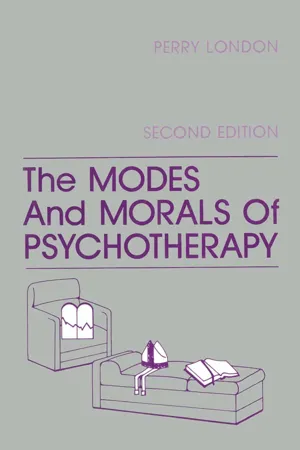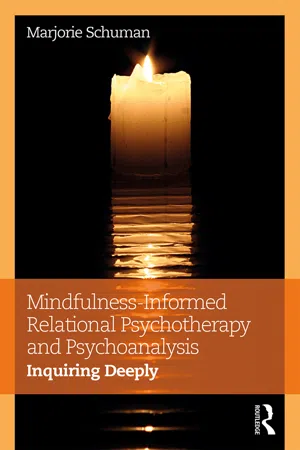Psychology
Insight Therapy
Insight therapy is a type of psychotherapy that focuses on helping individuals gain self-awareness and understanding of their thoughts, emotions, and behaviors. Through exploration and reflection, clients are encouraged to uncover underlying issues and gain insight into the root causes of their psychological challenges. This approach aims to promote personal growth and facilitate positive changes in behavior and relationships.
Written by Perlego with AI-assistance
Related key terms
6 Key excerpts on "Insight Therapy"
- eBook - ePub
- Perry London(Author)
- 2014(Publication Date)
- Taylor & Francis(Publisher)
IITHE HEALING MODES: Insight Therapy
THE ARGUMENTInsight Therapy is what most people have in mind when they think of “going into” psychotherapy. Their statements about it may be vague, but their idea of what happens there is correct. They fancy psychotherapy is “talking to someone” in ways which help to understand what “makes” them the way they are, expecting that the understanding thus obtained will relieve their inner stress. In those two simple terms, they grasp the essence of Insight method and theory.The technical differences that separate Insight schools are not substantial things to lay people. Lying on a couch, sitting upright, saying all that comes to mind, crying, screaming, analyzing dreams, writing fairy tales, admonishing empty chairs, punching pillows, recalling childhood, are all subordinate parts of what they know to be the centerpiece of Insight Therapy–expanding consciousness.This increase takes place chiefly by talking, and to someone who does not reciprocate in kind, does not trade information and experience, and is not sociable or friendly in the usual sense, but selflessly attends the client's self. Insight therapists of different schools answer differently to what patients say and do, aiming at their attitudes, their histories, the contradictions of their self-perceptions or the hidden feelings and ideas which orchestrate the ones they show. All of these are tools for focusing attention on the patient's self, which learns to be responsible for its expressions in the session, as in life, and to treat the therapist impersonally as a mirror of itself, a projection screen for its own ghosts, an instrument to use in hot pursuit of consciousness. - eBook - ePub
Person-Centred Counselling Psychology
An Introduction
- Ewan Gillon(Author)
- 2007(Publication Date)
- SAGE Publications Ltd(Publisher)
adaptation of unhealthy defences (i.e. challenging those which are dysfunctional or ‘immature’; Jacobs, 2005), rather than their elimination.Therapeutic approachThere is considerable disagreement between therapeutic approaches within the psychodynamic paradigm and the person-centred approach in terms of the nature of psychological therapy and its role in enabling change within the client. From a psychodynamic perspective, psychological change is a product of increased conscious awareness of previously unconscious impulses, motivations and defences. This outcome is viewed as best enacted through the direct analytic input of the therapist, whose primary role is to guide the client toward a greater degree of awareness by offering ‘interpretations’ of her actions and experiences in terms of the unconscious processes motivating them.Due to the emphasis on the developmental basis of psychological difficulties, psychodynamic interpretations orientate around the links between past and present, highlighting, for example, how present day adult relationships are informed by childhood experiences. The therapeutic focus is thus very much on what Jacobs (2005) terms ‘the presenting past’, a focus which allows previously unconscious material (feelings, motivations and related forms of psychological defence etc.) to be brought into conscious awareness and attended to.Person-centred therapy, by contrast, adopts a very different therapeutic focus, exploring the client’s perceptions and experiences in the present moment , with no agenda to encourage an exploration of how these link to the past unless wished by the client. Indeed, understanding childhood experiences is not seen as necessarily relevant to the process of change, which is instead viewed as a product of deepened experiencing of organismic feelings in the present (Davy and Cross, 2004). Furthermore, rather than viewing therapy as a process reliant on the ‘interpretations’ provided by a therapist, the emphasis within the person-centred approach is on trusting the client to contact her own organismic experiencing within the context of a supportive, facilitative therapeutic relationship. Neither ‘classical’ and ‘experiential’ traditions see a place for any therapist-derived interpretations of ‘unconscious’ processes, preferring instead to work collaboratively with - eBook - ePub
Counseling and Psychotherapy
A Christian Perspective
- (Author)
- 2011(Publication Date)
- Baker Academic(Publisher)
We can see that many of these examples of psychological treatments are already part and parcel of counseling and psychotherapy. Overview of Counseling and Psychotherapy: Theory Although over four hundred varieties of counseling and psychotherapy presently exist, most of them can be subsumed under the major schools of counseling and psychotherapy that are usually covered in textbooks in this field of people-helping. There are ten to twelve major ones, depending on the author and the text. In this book the following ten major theoretical approaches to counseling and psychotherapy will be covered in some detail, based on the theories and techniques developed by their founders and practitioners: psychoanalytic therapy, Adlerian therapy, Jungian therapy, existential therapy, person-centered therapy, Gestalt therapy, reality therapy, behavior therapy, cognitive behavior therapy and rational emotive behavior therapy, and marital and family therapy. Psychoanalytic Therapy. The key figure of psychoanalysis and psychoanalytic therapy is Sigmund Freud. He originated a theory of personality development focused on experiences in the first six years of life that determine the subsequent development of personality. Freudian or psychoanalytic theory emphasizes unconscious factors, especially sexual and aggressive drives in motivating human behavior. Psychoanalytic therapy employs techniques such as free association (allowing the client to say whatever comes to his or her mind without censorship); dream analysis (interpreting the latent or hidden meaning of the dream mainly through the use of symbols that have consistent significance for almost every person); and analysis of transference (when the client responds to the analyst or therapist as a significant person of authority from his or her life, thereby revealing childhood conflicts he or she has experienced). The goal of psychoanalytic therapy is to help make the unconscious conscious and strengthen the ego - eBook - ePub
- Allan Tasman, Jerald Kay, Jeffrey A. Lieberman, Michael B. First, Mario Maj(Authors)
- 2011(Publication Date)
- Wiley(Publisher)
Strupp (1986) specified that psychotherapy is the systematic use of a human relationship for therapeutic purposes of alleviating emotional distress by effecting enduring changes in a patient’s thinking, feelings, and behavior. The mutual engagement of the patient and the psychotherapist, both cognitively and emotionally, is the foundation for effective psychotherapeutic work. Whereas there are many different types of psychotherapy (Figure 87–1), the core task of the psychoanalytic psychotherapist is to make contact with and comprehend, as thoroughly as possible, the patient’s subjective inner world to engage in an analytical (i.e., interpretive) conversation about it (Ornstein and Kay 1990). This core task implies that all psychoanalytic psychotherapies may be further defined in terms of three operations: accepting, understanding, and explaining (Ornstein and Ornstein 1985) (Table 87–1). First, and more specifically, the therapist must engage with the patient by accepting the subjective experience of the patient’s emotional pain and conflict. This is achieved through the establishment of a therapeutic dialogue based on an empathic, nonjudgmental rapport. Second, within the process of listening to, and feeling with the patient, the therapist will begin to develop an understanding of the intricacies of the patient’s plight. Much of what the therapist observes may at first remain outside of the patient’s conscious awareness, manifested in the form of reenactments and reliving of earlier experiences within the therapy, rather than in deliberate, conscious, descriptive communication. Last, by the sharing of this beginning understanding with the patient through a simultaneously empathic and interpretive mode, both arrive at a deeper appreciation for the genesis of, and the reasons for, the patient’s symptoms - eBook - ePub
Counselling Psychology
A Textbook for Study and Practice
- David Murphy(Author)
- 2017(Publication Date)
- Wiley-Blackwell(Publisher)
It is important to distinguish between the terms “psychoanalytic” and “psychodynamic” when referring to clinical practice; both forms of therapy draw on psychoanalytic principles but the frequency of the sessions differs. Psychodynamic counselling psychologists are more likely to offer weekly sessions, whereas psychoanalysts may offer up to five sessions a week, which impacts the depth of the work and the therapeutic focus. Jacobs' (1988) general definition of the term “psychodynamic” is a useful one: “what particularly distinguishes the term ‘psychodynamic’ is that the activity of the psyche is not confined to relating to people, or to objects outside of the self. . . . Activity also takes place within the psyche, in relation to itself” (pp. 4–5).ONTOLOGICAL ASSUMPTIONS: IMAGE OF THE PERSON
In his initial topographic model of the human mind Freud outlined the fundamental premise of psychodynamic theory: that human thoughts, affective states, and motivation appear to be largely determined by unconscious forces as evidenced by dreams, slips of the tongue, and psychological symptoms originating from repressed unconscious material (Freud, 1900). The individual is driven by instinctual impulses—primitive sexual and aggressive drives that push for expression and in doing so clash with the social world and internalized social rules. This clash leads to internal conflict between instinctual impulses and the defences against them, and, according to Freud's later structural theory (Freud, 1923a), between the id, ego, and superego. An intrapsychic compromise therefore needs to be reached, yet as Greenberg (1996) notes “this is always a tragic compromise” (p. 89) that impacts personality development.Drive theory was challenged in the 1940s by object relations theorists such as Winnicott, Fairbairn, Guntrip, and Bowlby, who argued that the individual is motivated by the need for relationships; drives such as sexuality and aggression were conceptualized as operating within relationships rather than within the person - eBook - ePub
Mindfulness-Informed Relational Psychotherapy and Psychoanalysis
Inquiring Deeply
- Marjorie Schuman(Author)
- 2016(Publication Date)
- Routledge(Publisher)
Inquiring deeply focuses on the content of psychological narrative. The stories that we tell—about ourselves, about others, and about what we consider to be real—comprise the system of meaning in which we live. The therapeutic approach described in this book is based on the view that not only are these stories not “beside the point,” as Buddhist teachings often suggest, they are vital to self-understanding. As writer David Loy puts it, our world is made of stories (Loy, 2010).To summarize what has been said so far, inquiring deeply is mindful, psychodynamic, relational psychotherapy. The following basic premises can be articulated:• Inquiring deeply is a psychodynamic approach. By investigating problems and tracking experience as it unfolds over time, many psychodynamic processes can emerge clearly into view in a way that deepens self-understanding. Because the story lines of the person’s narrative can and will be understood differently by every listener, the therapist’s attuned understanding is an essential ingredient of good psychotherapy. Perceptive mirroring on the part of the therapist is essential. (If we could see our own blind spots, they wouldn’t be blind!)• Inquiring deeply is a relational psychotherapeutic framework. It explores the relational dimension of how the mind is organized. Relational patterns in the patient’s life are explored, especially those which are problematic in nature. By focusing closely on what is enacted in the patient’s life and the stories that are being told about those events, it becomes evident that the psychological world of lived experience is constructed around a complex “relational matrix ”which encodes our history with others.• Inquiring deeply is a psychoanalytic approach. Since the Here and Now of psychotherapy is a microcosm of the patient’s way of being in the world, the therapeutic relationship itself is often a fruitful area of inquiry. By bringing the process of the shared therapeutic experience into the foreground, insight emerges. To do this well, therapists need to participate in the emotional experience—in the being
Learn about this page
Index pages curate the most relevant extracts from our library of academic textbooks. They’ve been created using an in-house natural language model (NLM), each adding context and meaning to key research topics.





